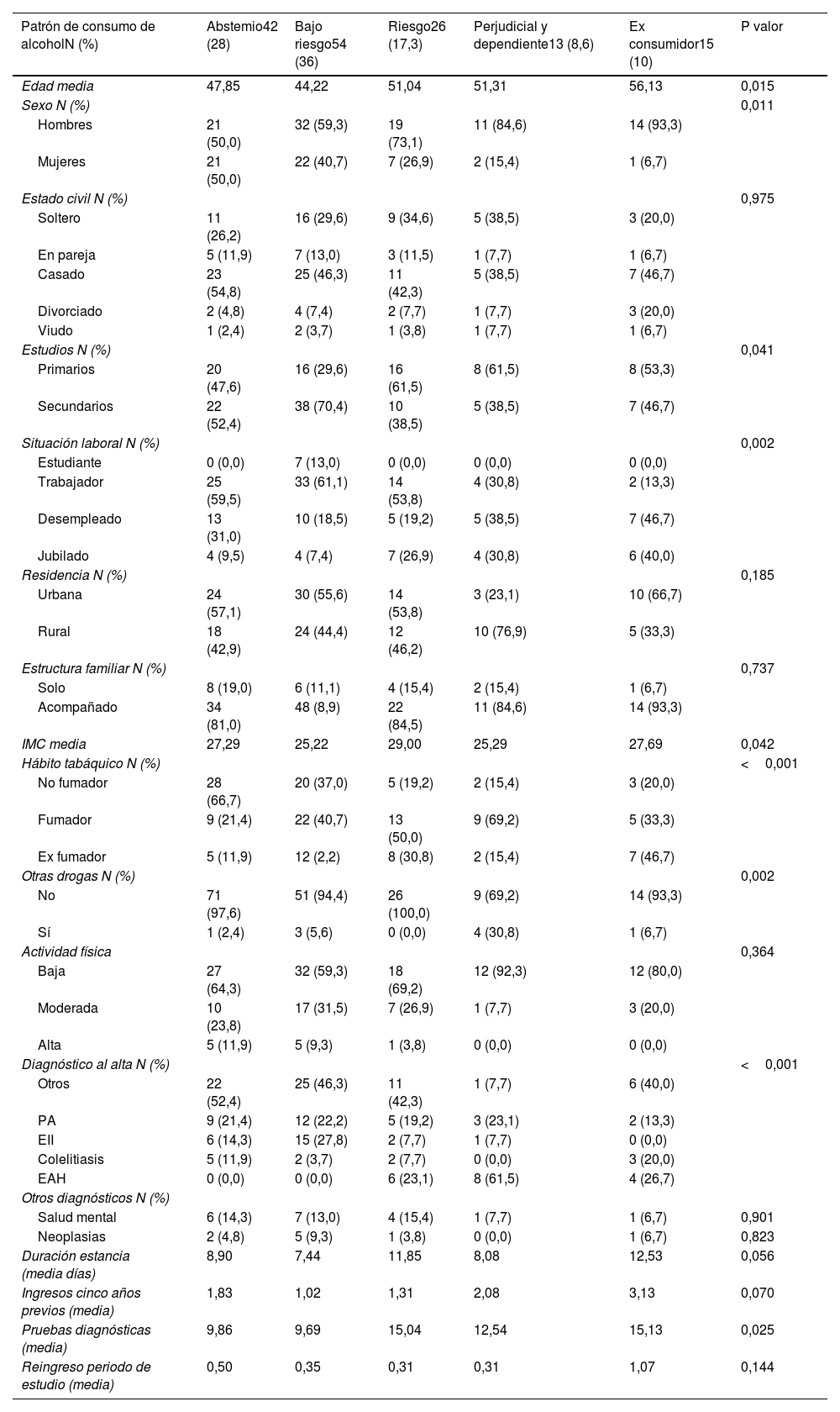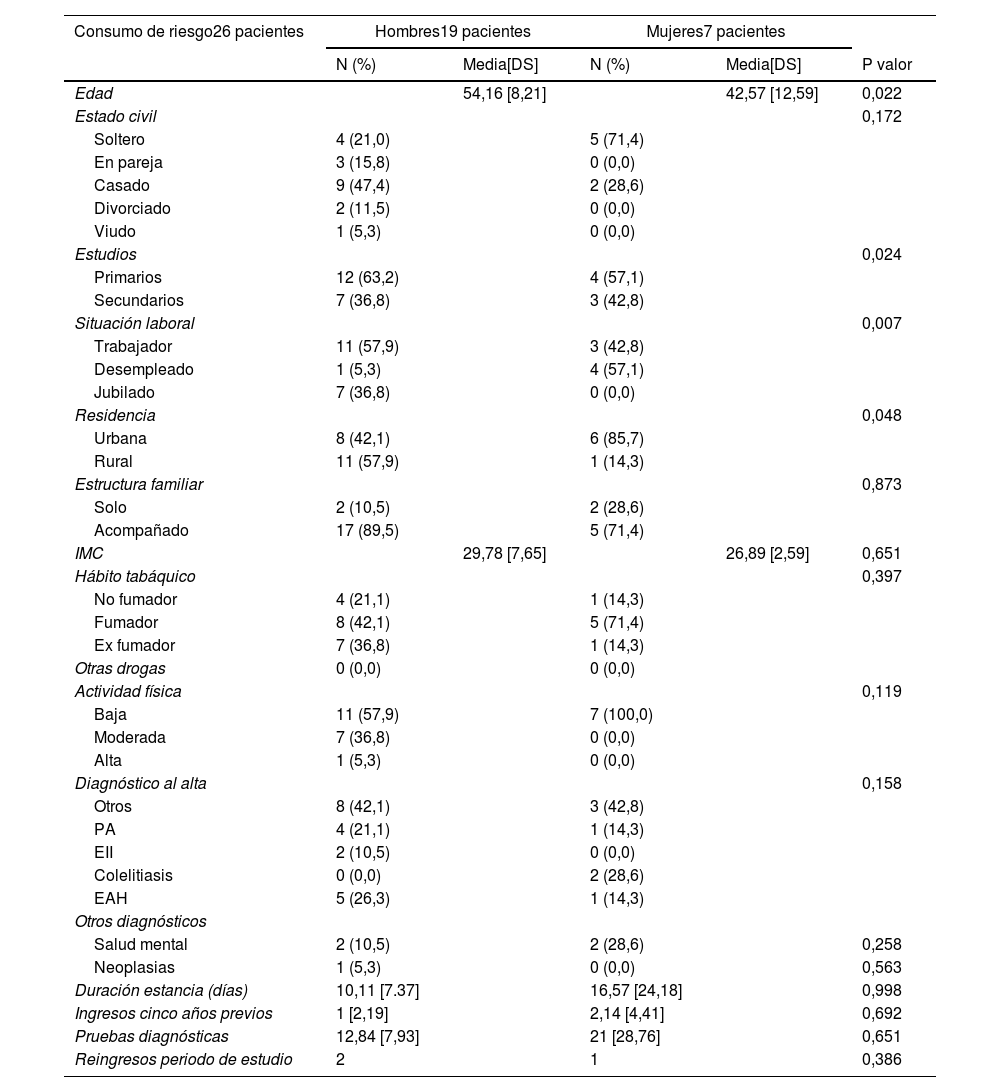Determinar el patrón de consumo de alcohol, el perfil sociodemográfico, de hábitos y clínico de los pacientes ingresados y explorar la utilidad del cuestionario Alcohol Use Disorders Identification Test (AUDIT) para realizar la detección del consumo de alcohol en la Unidad de Gestión Clínica (UGC) de Digestivo del Hospital Universitario Juan Ramón Jiménez (HUJRJ), de Huelva.
MétodoEstudio cuantitativo observacional analítico transversal. Se reclutaron 150 participantes.
ResultadosSegún AUDIT, el 36% de los pacientes presentaba un perfil de bajo riesgo, el 17,3% de los pacientes tenían un consumo de riesgo y el 8,6% mantenían un consumo perjudicial o eran posibles dependientes. Un 28% refirieron no consumir nunca alcohol y un 10% se confirmaron ex consumidores. Se obtuvo asociación significativa (p<0,01) entre el patrón de consumo de alcohol y las variables situación laboral, hábito tabáquico, ser consumidor de otras drogas y diagnóstico al alta. No resultaron significativas la variable edad (p=0,015), sexo (p=0,011) y número de pruebas diagnósticas durante el ingreso (p=0,025). Se observó diferencia significativa (p<0,01) entre hombres y mujeres con perfil de consumo de riesgo en la variable situación laboral. El 23,1% de los consumidores de riesgo presentaba enfermedad alcohólica del hígado.
ConclusionesLa estratificación de los pacientes ingresados en el HUJRJ según el consumo de alcohol a través del AUDIT ha revelado distintos perfiles sociodemográficos, de hábitos y clínicos. La detección del patrón de consumo de alcohol en Atención Especializada realizada por enfermería podría mejorar la estrategia de atención de dichos pacientes.
To determine the pattern of alcohol consumption, the sociodemographic, habit and clinical profile of the patients admitted and to explore the usefulness of the Alcohol Use Disorders Identification Test (AUDIT) questionnaire for detecting alcohol consumption in the Digestive Unit of the Juan Ramón Jiménez University Hospital (HUJRJ) of Huelva.
MethodsCross-sectional observational analytical quantitative study. A total of 150 participants were recruited.
ResultsAccording to AUDIT, 36% of the patients had a low-risk profile, 17.3% of the patients had risky consumption and 8.6% had harmful consumption or were possibly dependent. 28% reported never consuming alcohol and 10% were confirmed ex-consumers. There was a significant association (p<0.01) between the pattern of alcohol consumption and the variables employment status, smoking, use of other drugs and diagnosis at discharge. The variables age (p 0.015), sex (p 0.011) and number of diagnostic tests during admission (p 0.025) were not significant. A significant difference (p<0.01) was observed between men and women with a risky consumption profile in the work situation variable. Of the risk consumers, 23.1% had alcoholic liver disease.
ConclusionsStratification of patients admitted to the HUJRJ according to alcohol consumption through AUDIT has revealed different sociodemographic, habit and clinical profiles. The detection of the pattern of alcohol consumption in Specialized Care by nurses could improve the care strategy for these patients.
Artículo
Comprando el artículo el PDF del mismo podrá ser descargado
Precio 19,34 €
Comprar ahora








